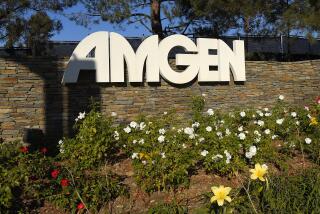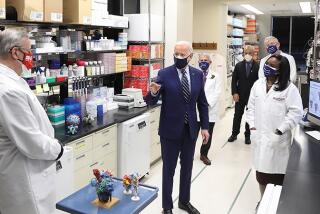No Plans to Hype Promising Anemia Treatment : Amgen Plays It Cool Despite Clamor Over EPO
- Share via
The phone calls start coming in at 6 a.m. at Amgen’s headquarters in Thousand Oaks. Since Thursday, when the U.S. Food and Drug Administration gave Amgen the go-ahead to sell its new biotechnology drug called erythropoietin (EPO), there have been more than 1,000 calls from doctors, patients and drug distributors who all want to know when they are going to get their hands on the new drug.
EPO, which treats chronic anemia in patients with kidney disease, is “the most important development since dialysis” in treating kidney disease, says Dr. Allen Nissenson, a professor at the UCLA school of medicine. The drug may also combat various types of anemia, including those suffered by patients with cancer or AIDS. “This is a wonder drug,” says Peter Drake, a biotechnology analyst with Vector Securities, who expects the total EPO market in the United States to reach $600 million a year by the early 1990s.
While doctors can’t wait to buy the drug, stock brokers are in a mad rush to trade Amgen’s stock. Since the start of last week Amgen’s stock price has surged 20%, closing Tuesday at $46.50. But amid all the clamor, Amgen’s executives have been playing it cool. Instead of talking up how much EPO they can sell, the company is calmly and methodically following the marketing plan it laid out 12 months ago.
“We have not hyped this drug. We’ve tried to understate what the potential is and to make sure our statements are conservative,” said Amgen’s president, Harry Hixson Jr.
Why? Amgen is trying to avoid the great-expectations-gone-bad that scarred Genentech’s reputation last year. The San Francisco company seemed to have a can’t-miss biotech drug with TPA, a blood clot-dissolving drug used to treat heart attack patients. Wall Street expected Genentech to sell $400 million of TPA last year, but instead Genentech sold less than half that, and sales were so slow that at year-end the company had to destroy some of its TPA inventory. During the past 20 months, Genentech’s stock has sunk from about $47 to $18.875 on Tuesday.
But analyst Drake says EPO is “totally different.” Unlike TPA, he says, there are no major uncontrollable side effects from EPO, the medical value of the drug is clear-cut, and while there are conventional heart drugs that cost one-tenth the price of TPA, there is no alternative to EPO.
One that reason Amgen remains cautious is that the company figures it will have a head start of only four-to-six months selling EPO. Chugai-Upjohn, a joint venture between mighty Japanese and American pharmaceutical companies, is expected to get FDA approval later this year to sell its version of EPO.
In the meantime, Amgen’s goal is to get EPO into the hands of its primary market--kidney dialysis patients--and build up some old-fashioned brand loyalty for its product, which will be sold under the name Epogen. Brand loyalty in biotechnology? “It’s no different than if you’re selling sneakers,” says Mark Brand, Amgen’s director of communications.
Amgen’s first shipments of EPO, packed in blue ice to keep it refrigerated, went out Friday via Federal Express. Dale James, drug inventory manager for FoxMeyer, a Dallas-based drug distributor, expects her first shipment of EPO today. “This drug is going to move,” James said. “Our largest hospital account in Kansas City has been asking for a shipment since last Friday.”
Licensing Fees
After Chugai-Upjohn starts selling EPO, Hixson says it’s “reasonable” to expect Amgen to control 70% of the kidney dialysis market. Chugai-Upjohn, he says, will have “to go to the patients and say our drug is better than the one you’ve been receiving. Our belief is that the patients will say, ‘I’m doing fine and I feel wonderful. Why should I change?’ ”
Drake figures that Amgen’s head start will ensure Amgen about $150 million a year in EPO sales from the kidney dialysis market, with more coming from licensing fees. (Amgen has licensed sales of EPO for all other uses in the United States to a subsidiary of Johnson & Johnson.)
EPO is a protein produced in the kidneys that triggers the production of red blood cells, which transport oxygen throughout the body. People with kidney disease can’t produce enough red blood cells, so they suffer debilitating anemia.
About 100,000 people in this country must endure kidney dialysis several times a week. They are attached to a machine so the toxins can be filtered from their blood. About 25,000 of those patients also need frequent blood transfusions, and doctors say that virtually all those getting transfusions, and a majority of the remaining dialysis patients, are prime EPO candidates.
Boosts Energy
By March, Amgen had booked about $15 million worth of orders from drug wholesalers, as word spread in the medical community about the splendid EPO clinical test results. For the past 20 months Robert Klein, 66, of North Hollywood, has been treated with EPO as part of a clinical test and he is enthusiastic about the drug.
For the first 12 weeks of the trial half of the 96 patients in Klein’s test group, he says, were injected with EPO; the others got placebos. “After the first week I knew I was on the real thing,” Klein said. “I was able to walk two miles, swim 20 laps at an Olympic-sized pool. I went to the clinic and said, ‘Hey, I’m on the real thing.’ You could tell. The energy level is tremendous. You jump up and down like Howdy Doody.”
Klein still needs dialysis treatments, but like most EPO patients he almost never needs blood transfusions, and so avoids the risk of getting AIDS or hepatitis from a tainted blood supply.
However impressive EPO is medically, it is an expensive drug, likely to cost from $4,000 to $8,000 per patient per year. Dr. Steven Tucker, a nephrologist in Anchorage, Alaska, wants the drug for his dialysis patients, but he says, “I can’t order it yet because a major question is who is going to pay for it.”
The payment question is critical because EPO seems like a promising treatment for a wide variety of anemia. Dr. David Golde, head of hematology and oncology at UCLA, is testing EPO on AIDS patients who are taking the drug AZT, which has various side effects including anemia. And Golde says EPO seems to help. About 40,000 Americans take AZT and Golde says a majority of them could be candidates for EPO, and that’s only the start. “It’s just a matter of time before EPO is widely used for a number of other indications,” he says.
The final details of the federal government’s EPO reimbursement program won’t be settled until next week. But Charles Booth, director of payment policy for the federal Health Care Financing Administration, says Medicare will pick up most of the cost for EPO--about 80% he suggests--for those suffering from chronicly low red blood cell counts, no matter what the disease.
How much will EPO cost the government? A year from now Booth guesses that the government’s tab will hit an annualized rate of $175 million. As EPO use becomes more widespread, he concedes, that figure will rise. How high? “There is no precedent for this,” Booth said.
Tucker figures the government’s EPO bill will eventually be closer to $1 billion a year. “From a medical standpoint it will be very difficult, if not impossible, to deny anybody this drug.”
Given how cautious Amgen’s forecasts are, could the company be caught short by a big demand for EPO? After all, it takes Amgen about four months to make a batch of EPO because the gene-spliced cells incubate slowly.
Hixson says that being cautious isn’t the same as being unprepared. “We already have one year’s inventory of bulk drug made. It’s in frozen concentrate. We have at least $100 million worth.” In its final form, he says, EPO has a two-year shelf life.
More to Read
Inside the business of entertainment
The Wide Shot brings you news, analysis and insights on everything from streaming wars to production — and what it all means for the future.
You may occasionally receive promotional content from the Los Angeles Times.











